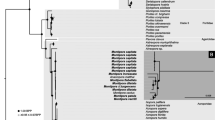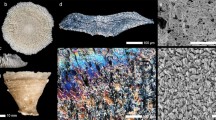Abstract
The complete nucleotide sequence of the mitochondrial (mt) genome was determined for specimens of the coral species Montipora cactus (Bernard 1897) and Anacropora matthai (Pillai 1973), representing two morphologically distinct genera of the family Acroporidae. These sequences were compared with the published mt genome sequence for the confamilial species, Acropora tenuis (Dana 1846). The size of the mt genome was 17,887 bp and 17,888 bp for M. cactus and A. matthai. Gene content and organization was found to be very similar among the three Acroporidae mt genomes with a group I intron occurring in the NADH dehyrogenase 5 (nad5) gene. The intergenic regions were also similar in length among the three corals. The control region located between the small ribosomal RNA (ms) and the cytochrome oxidase 3 (cox3) gene was significantly smaller in M. cactus and A. matthai (both 627 bp) than in A. tenuis (1086 bp). Only one set of repeated sequences was identified at the 3′-end of the control regions in M. cactus and A. matthai. A lack of the abundant repetitive elements which have been reported for A. tenuis, accounts for the relatively short control regions in M. cactus and A. matthai. Pairwise distances and relative rate analyses of 13 protein coding genes, the group I intron and the largest intergenic region, igr3, revealed significant differences in the rate of molecular evolution of the mt genome among the three species, with an extremely slow rate being seen between Montipora and Anacropora. It is concluded that rapid mt genome evolution is taking place in genus Acropora relative to the confamilial genera Montipora and Anacropora although all are within the relatively slow range thought to be typical of Anthozoa.


Similar content being viewed by others
References
Beagley CT, Macfarlane JL, Pont-Kingdon G, Okimoto R, Okada NA, Wolstenholme DR (1995) Mitochondrial genomes of Anthozoa (Cnidaria). In: Palmieri F, Papa S, Saccone C, Galadaleta N (eds) Progress in cell research—symposium on thirty years of progress in mitochondrial bioenergetics and molecular biology. Elsevier, Amsterdam, pp 149–153
Beagley CT, Okada NA,Wolstenholme DR (1996) Two mitochondrial group I introns in a metazoan, the sea anemone M. senile: one intron contains genes for subunits 1 and 3 of NADH dehydrogenase. Proc Natl Acad Sci, USA 93:5619–5623
Beagley CT, Okimoto R, Wolstenholme DR (1998) The mitochondrial genome of the sea anemone, M. senile (Cnidaria): introns, a paucity of tRNA genes, and a near-standard genetic code. Genetics 148:1091–1108
Beaton MJ, Roger AJ, Cavalier-Smith T (1998) Sequence analysis of the mitochondrial genome of Sacrophyton glaucum: conserved gene order among octocorals. J Mol Evol 47:697–708
Bridge D, Cunningham CW, Schierwater B, DeSalle R, Buss L (1992) Class-level relationships in the phylum Cnidaria: evidence from mitochondrial genome structure. Proc Natl Acad Sci, USA 89:8750–8753
Chang CC (2004) Multi-loci approach to molecular phylogeny of reef-building corals, the genus Montipora (Scleractinia; Acroporidae). Msc thesis, Institute of Oceanography, National Taiwan University, p 51
Chen CA, Yu J-K (2000) Universal primers for amplification of mitochondrial small subunit ribosomal RNA-encoding gene in scleractinian corals. Mar Biotech 2:146–153
Chen CA, Wallace CC, Wolstenholme J (2002) Analysis of mitochondrial 12S RNA gene supports a two-clade hypothesis of the evolutionary history of scleractinian corals. Mol Phyl Evol 23:137–149
Chen CA, Chang CC, Wei NV, Chen CH, Lein YT, Lin HE, Dai CF, Wallace CC (2004) Secondary structure and phylogenetic utility of ribosomal internal transcribed spacer 2 (ITS2) in scleractinian corals. Zool Stud 43:759–771
Cheng S, Chang SY, Gravitt P, Respess R (1994) Long PCR. Nature 369:684–685
Fukami H, Omori M, Hatta M. (1999) Phylgenetic relationships in the coral family Acroporidae, reassessed by inference from mitochondrial genes. Zoo Sci 17:689–696
Hsieh HJ, Wei NV, Lu Y-I, Jeng M-S, Tsai W-S, Chen CA (2001) An unexpected high coral coverage in Chinwan Inner Bay, Pescadores: A potential site for Marine Protection Area. Coral Reefs 20:316–317
Kumar S, Tamura K, Jakobsen IB, Masatoshi N (2001) MEGA2: Molecular Evolutionary Genetics Analysis softwares. Arizona Sate University, Tempe
Lavrov DV, Boore JL, Brown WM (2000) The complete mitochondrial DNA sequence of the horseshoe crab Limulus polyphemus. Mol Biol Evol 17:813–824
Márquez LM, van Oppen MJH, Willis BL, Miller DJ (2002a) Sympatric populations of the highly cross-fertile coral species Acropora hyacinthus and A. cytherea are genetically distinct. Proc Royal Soc, London, Series B 269:1289–1294
Márquez LM, van Oppen MJH, Willis BL, Reyes A, Miller DJ (2002b) The highly cross-fertile coral species, Acropora hyacinthus and A. cytherea, constitute statistically distinguishable lineages. Mol Ecol 11:1339–1349
van Oppen MJH, Willis BL, Miller DJ (1999a) Atypically low rate of cytochrome b evolution in the scleractinian coral genus Acropora. Proc Roy Soc, London, Series 266:179–183
van Oppen MJH, Hislop NR, Hagerman PJ, Miller DJ (1999b) Gene content and organization in a segment of the mitochondrial genome of the scleractinian coral Acropora tenuis: major differences in gene order within the anthozoan subclass Zoantharia. Mol Biol Evol 16:1812–1815
van Oppen MJH, McDonald BJ, Willis BL, Miller DJ (2001) The evolution history of the coral genus Acropora (Scleractinia, Cnidaria) base on a mitochondrial and a nuclear marker: reticulation, incomplete lineage sorting or morphological convergence? Mol Biol Evol 18:1315–1329
van Oppen MJH, Catmull J, McDonald BJ, Hislop NR, Hagerman PJ, Miller DJ (2002) The mitochondrial genome of Acropora tenuis (Cnidaria; Scleractinia) contains a large group I intron and a candidate control region. J Mol Evol 55:1–13
Pont-Kingdon G, Okimoto R, Macfarlane JL, Beagley CT, Watkin-Sims CD, Cavalier-Smith T, Clark-Walker DG, Wolstenholme DR (1998) Mitochondrial DNA of the coral Sacrophyton glaucum contains a gene for a homologue of bacterial MutS: a possible case of gene transfer from the nucleus to the mitochondrion. J Mol Evol 46:419–431
Rand DM, Harrison RG (1989) Molecular population genetics of mtDNA size variation in crickets. Genetics 121:551–569
Romano S, Palumbi S (1997) Molecular evolution of a portion of the mitochondrial 16S ribosomal gene region in scleractinian corals. J Mol Evol 45:397–411
Shearer TL, van Oppen MJH, Romanos SL, Worheide G (2002) Slow mitochondrial DNA sequence evolution in the Anthozoa (Cnidaria). Mol Ecol 11:2475–2487
Swofford D (2002) Phylogenetic analysis using parsimony v. 4.0b10 Sinauer, Sunderland
Tajima F (1993) Simple methods for testing molecular clock hypothesis. Genetics 135:599–607
Veron JEN (1995) Corals in space and time, the biogeography and evolution of Scleractinia. UNSW, Sydney
Veron JEN (2000) Corals of the world. Australian Institute of Marine Science, Townsville
Veron JEN, Wallace CC (1986) Scleractinia of the eastern Australia—Family Acroporidae. Australian Institute of Marine Science, Townsville
Vollmer SV, Palumbi SR (2002) Hybridization and the evolution of reef coral diversity. Science 296:2023–2025
Wallace CC (1999) Staghorn corals of the world: A revision of the genus Acropora. CSIRO, Collingwood
Wolstenholme DR (1992) Animal mitochondrial DNA: structure and evolution. Int Rev Cytol 141:173–216
Zhang DX, Szymura JM, Hewitt GM (1995) Evolution and structure conservation of the control region of insect mitochondrial DNA. J Mol Evol 40:381–391
Acknowledgements
The authors wish to thank Jackie Wolstenholme for sample collection during the 1999 Tethyana expedition, and the staffs of the Penghu Aquarium for logistic support during coral spawning trips in 2002. Many thanks to Chang-Feng Dai, Jackie Wolstenholme, and Paul Muir, members of the Evolution and Ecology discussion group, and two anonymous reviewers for their constructive comments. This work was supported by grants from the Australian Research Council to C.C.W. and Institute of Zoology/Research Centre for Biodiversity, Academia Sinica (IZAS/RCBAS) to C.A.C. This is the Evolution and Ecology Group, IZAS/RCBAS Contribution no. 29.
Author information
Authors and Affiliations
Corresponding author
Rights and permissions
About this article
Cite this article
Tseng, CC., Wallace, C.C. & Chen, C.A. Mitogenomic analysis of Montipora cactus and Anacropora matthai (cnidaria; scleractinia; acroporidae) indicates an unequal rate of mitochondrial evolution among Acroporidae corals. Coral Reefs 24, 502–508 (2005). https://doi.org/10.1007/s00338-005-0499-x
Received:
Accepted:
Published:
Issue Date:
DOI: https://doi.org/10.1007/s00338-005-0499-x




